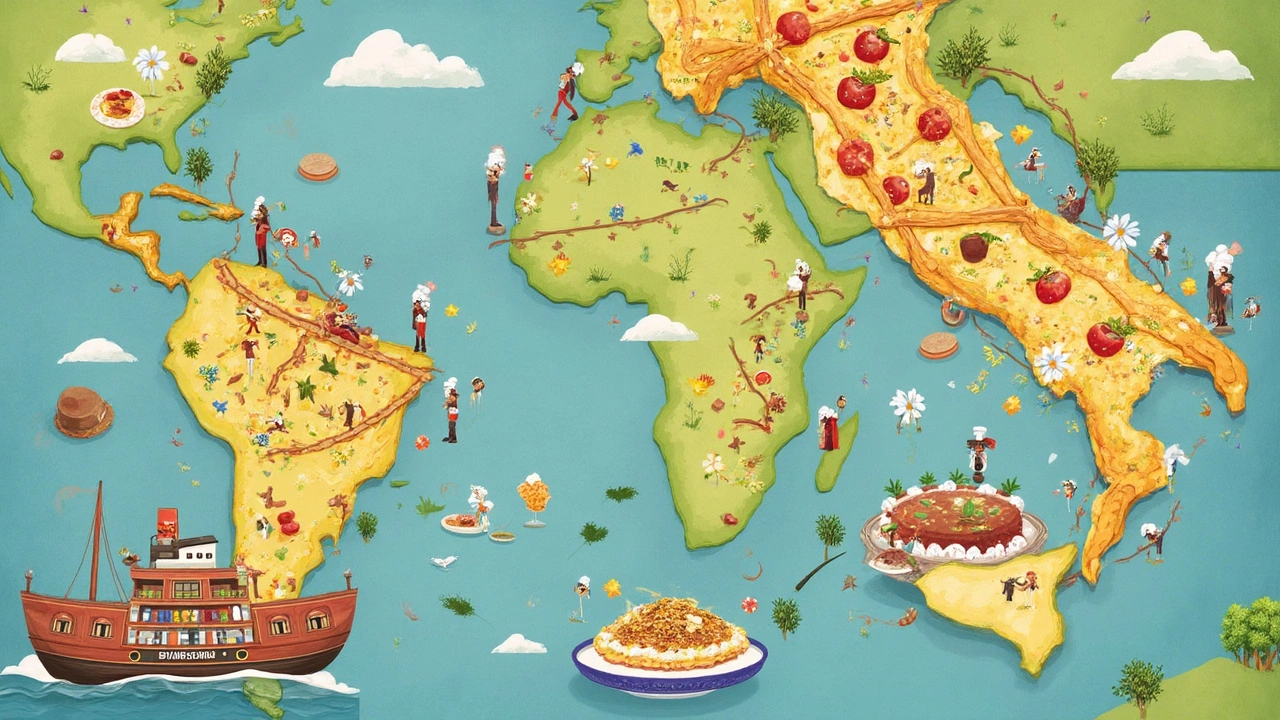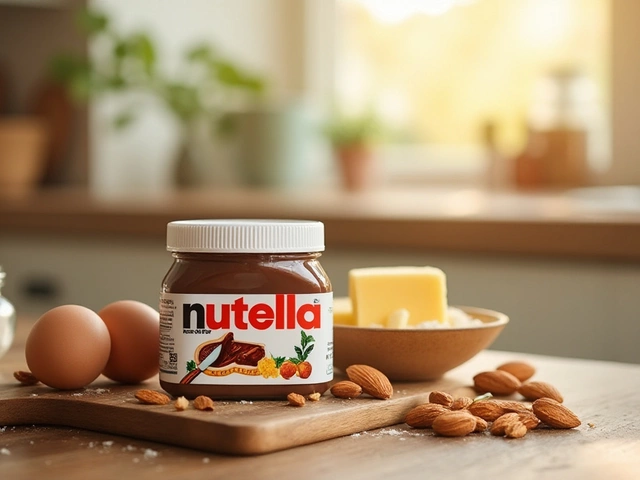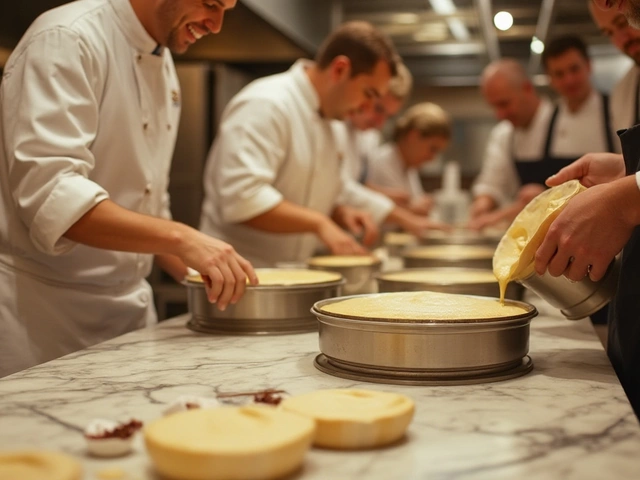
It's wild how many foods you eat in Brazil that didn't even exist here a little more than a hundred years ago. Walk into any bakery, and you’ll spot things like lasagna, gnocchi, and, of course, tiramisu, all mixed in with pão de queijo and brigadeiro. Ever wondered who started this food mashup? The answer is: the Italian immigrants who started arriving in Brazil in droves at the end of the 19th century.
They didn’t just bring recipes. Italians brought an attitude about eating—family-style, loud, and filled with flavor. They planted gardens, used local cheeses when they couldn't find parmesan, and rolled gnocchi with sweet potatoes when regular potatoes were too expensive. If you’ve ever dug into a creamy tiramisu at a Brazilian party, you’re already tasting history—one that mixes traditions from both sides of the ocean.
- Italy Arrives in Brazil: A Quick Backstory
- From Lasagna to Tiramisu: What Made the Trip
- How Italian Food Changed in Brazil
- Why Tiramisu Is More Than a Dessert
- Tips for Tasting Real Italian Cuisine in Brazil
Italy Arrives in Brazil: A Quick Backstory
If you flip through Brazil's history books, you’ll find out that Italian immigration kicked off big time in the late 1800s, especially after slavery was abolished in 1888. Many families left regions like Veneto and Calabria, hoping for a fresh start. Most of them landed in São Paulo and the southern states, looking for work on coffee plantations or in growing cities.
By 1920, nearly 1.5 million Italians had made Brazil their new home, according to official records. It's not exaggerating to say they changed the face—and flavor—of the country. Just take a walk through São Paulo’s neighborhoods like Brás, Mooca, or Bela Vista, and you’ll see it in the street names, bakeries, and, of course, the food.
These immigrants didn't arrive with suitcases full of pasta and cheese (I wish!), but they did bring recipes and a love for home cooking. From day one, they started mixing what they knew with what they found in Brazil: local veggies, tropical fruit, and even different types of flour. Over time, homesick Italian grandmas swapped pecorino for queijo minas and folded new ingredients into their old traditions. The result? A whole new blend of flavors—part Italian, part Brazilian.
That’s how Italian foods like lasagna, polenta, pizza, and, yes, tiramisu found a place at the Brazilian table. These dishes weren’t just about nostalgia—they created comfort for new generations and turned into staples you’d find at any family celebration.
From Lasagna to Tiramisu: What Made the Trip
Italian families brought a surprising amount of their favorite recipes across the Atlantic to Brazil, and these dishes quickly fit right into local kitchens. We're not talking about just pizza or spaghetti either. Dishes like lasagna, polenta, risotto, and gnocchi started showing up in home kitchens and bakeries in São Paulo, Rio Grande do Sul, and beyond.
Let’s talk lasagna for a second. In Italy, it was already a hit, but it got extra love in Brazil. Immigrant families layered it with whatever cheese they could get—sometimes even Queijo Minas instead of mozzarella or parm. Each Sunday, you'd find entire families gathered around a lasagna, especially in cities with big Italian communities.
Gnocchi was another big one. Traditionally made with potatoes, Italians in Brazil quickly swapped in mandioca (cassava), sweet potato, or even pumpkin. The famous "gnocchi of the 29th"—a day when people eat gnocchi for good luck—became a thing in Brazil just like in Italy.
Polenta, super basic in Northern Italy, turned into a staple here, too. Italian farmers in the South tossed cornmeal with all sorts of Brazilian ingredients and made creamy or grilled versions for simple, family meals.
Now, about tiramisu. This creamy dessert—literally meaning "pick-me-up" in Italian—came a bit later, but Brazilians jumped on board fast once it showed up in bakeries and dessert shops in the 1980s. Instead of mascarpone, some local recipes use requeijão cremoso or even cream cheese when the real stuff is too pricey. That’s real kitchen creativity! If you see tiramisu on a menu in São Paulo or Porto Alegre, chances are someone is mixing up tradition with whatever they can find locally.
- Italian foods in Brazil include way more than pasta: think lasagna, gnocchi, risotto, polenta, and that iconic tiramisu.
- Many recipes changed based on what was available locally—sometimes creating new classics you’ll only find in Brazil.
- If you want to taste the real deal, some bakeries or Italian-Brazilian families today still use grandma's recipes straight from their homeland.

How Italian Food Changed in Brazil
When Italians showed up in Brazil, they had to get creative. Farmers and cooks couldn't always find the same stuff they used back in Italy, so they swapped ingredients for whatever was on hand. For example, mozzarella was often replaced with the cheese Minas from Minas Gerais, and people used cassava flour where they’d normally use wheat flour for things like gnocchi or bread. Even the tomato sauce got a makeover—sometimes sweeter or cooked with local spices.
Pasta, which is a staple in both Italy and Brazil now, became common in São Paulo and Rio thanks to all the Italian families running their own restaurants and cantinas. Over time, lasagna in Brazil started showing up with more layers of cheese and even a layer of ham. The typical Brazilian pizza isn’t the thin, crispy type you find in Naples—it’s often loaded with cheese, sometimes covered in catupiry, a creamy cheese that’s super popular here. By the way, catupiry is pure Brazilian invention. Classic Italian desserts also picked up some new flavors—tiramisu, for example, sometimes gets made with doce de leite or local cookies instead of ladyfingers.
| Dish | Original Italian Version | Brazilian Twist |
|---|---|---|
| Lasagna | Thin layers, usually with béchamel | Extra cheese, sometimes ham, thicker layers |
| Pizza | Thin crust, light toppings | Thick, cheesy, catupiry, heartier toppings |
| Gnocchi | Potato dumplings, simple tomato sauce | Cassava or sweet potato, sometimes with meat sauce |
| Tiramisu | Ladyfingers, mascarpone, espresso | Cookies like champagne biscuits, doce de leite, local coffee |
It’s not just about the ingredients—eating habits changed too. Sunday pasta is now a tradition for tons of Brazilian families, even those who aren’t Italian. Italian food isn’t just a special meal; it’s comfort food here. If you ever walk through Mooca or Bela Vista in São Paulo, you’ll see Italian shops on almost every corner and bakeries baking up new versions of old favorites.
So when you bite into a slice of pizza with requeijão or a piece of gnocchi made with cassava, you’re actually eating a little piece of both Italian and Brazilian history. That mix is what makes the Italian foods in Brazil so unique and seriously tasty.
Why Tiramisu Is More Than a Dessert
Sure, tiramisu is sweet, creamy, and looks fancy on the table. But it’s not just a treat you eat with coffee after Sunday lunch—it’s become a piece of family history for lots of Brazilian families with Italian roots. The word "tiramisu" actually means "pick me up" in Italian, because of all the espresso and sugar packed in every layer. It's got way more meaning than you’d guess from looking at a glass baking dish.
This dessert started showing up in Brazil as early as the 1970s, first at high-end restaurants in São Paulo and Rio, then spreading to home kitchens. For families, making tiramisu became a way to remember Italian grandparents or that aunt who always had a surprise at the end of a meal. Now, it’s a regular on holiday tables, birthdays, or whenever you want to impress your guests.
There’s also something cool about how Brazilians have tweaked tiramisu to fit local tastes and what’s in the supermarket. Some swap out expensive mascarpone for creamy requeijão or fresh cheese, and it still works. The espresso sometimes gets traded for strong Brazilian coffee. You’ll even find versions with a touch of cachaça or chocolate powder on top for a playful twist. It’s a perfect example of how Italian foods adapt and thrive in a new place.
And don’t forget: making tiramisu is social. Whether you’re dunking ladyfingers in coffee with your kids or layering cream with your mom, it’s an excuse to gather. The conversation is as important as the final taste. That’s what really turned tiramisu into something special in Brazil – it’s not just dessert, it’s a memory-maker and a bridge between two cultures.

Tips for Tasting Real Italian Cuisine in Brazil
If you’ve ever wondered whether you’re eating the real deal or just another Brazilian remix, here’s how to spot genuine Italian food in Brazil. The hype is real—there’s a huge range, from old-school trattorias started by Italian families to pizza chains with little connection to Italy.
First: check the ingredients. Authentic places don’t swap olive oil for vegetable oil or drown pasta in too much sauce. You want simple, quality basics: tomatoes, garlic, basil, parmesan (preferably not the powder from a can), and fresh pasta if possible.
Here’s what I look for when my kids, Dariel and Thalia, are picking out something Italian:
- Italian foods: If the restaurant serves caprese salad, risotto alla milanese, or cannoli, it’s probably legit. Tiramisu should be creamy and have a strong coffee punch—not sugary and overloaded with cream cheese.
- Ask about the cheese. Italians in Brazil often use grana padano or parmigiano instead of the typical supermarket stuff. If you see catupiry as a topping on pizza, that’s a Brazilian twist (delicious, but not classic Italian).
- Look for generational places. Spots with faded family photos on the wall, or a nona (grandma) still greeting guests, often keep things real. São Paulo’s Bixiga neighborhood is ground zero for these.
- Pasta should be al dente, not mushy. Sauces are simple: try carbonara made with egg, cheese, and pork—never cream. Fresh gnocchi is pillowy, not gummy.
- Italian wine lists can be a giveaway. Real Italian restaurants stock at least a few bottles from Italy. Not a wine drinker? Espresso after a meal is also classic.
Restaurants and bakeries in places like São Paulo, Rio, and Bento Gonçalves have won awards for authentic Italian dishes. Here’s a quick look at some top cities for an Italian food fix:
| City | Known For | Signature Italian Dish |
|---|---|---|
| São Paulo | Largest Italian community in Brazil | Lasagna, panettone, pizza napolitana |
| Rio de Janeiro | Traditional family-run trattorias | Tiramisu, pasta al forno |
| Bento Gonçalves | Home of the Italian Wine Route | Polenta, vin brulé, homemade ravioli |
Last tip: ask for dessert! Tiramisu still divides opinions—some prefer the old-school version with lots of espresso, while others add a dash of cachaça for a local twist. Either way, you’ll taste a slice of real Italian heritage mixed with Brazilian flair.





